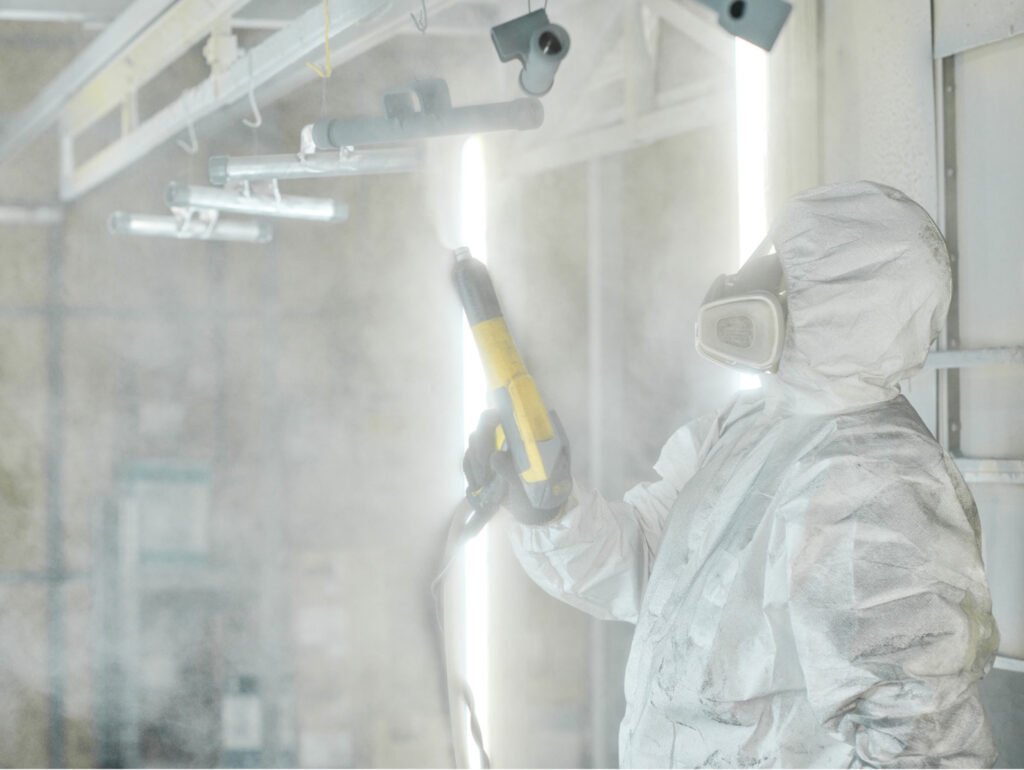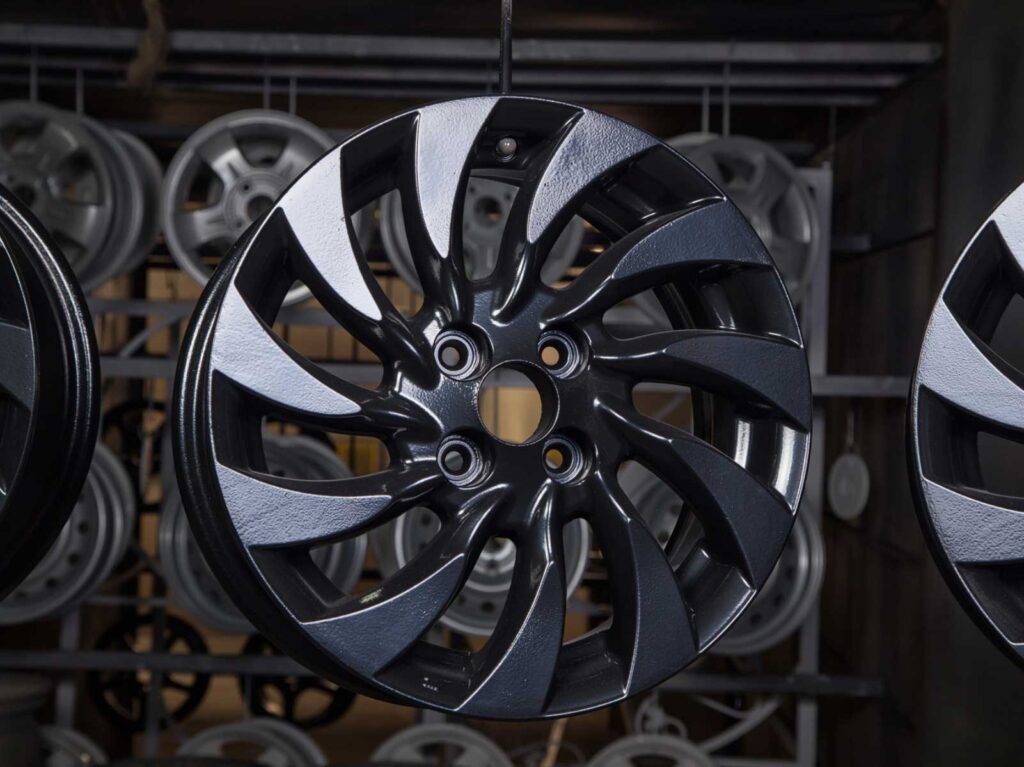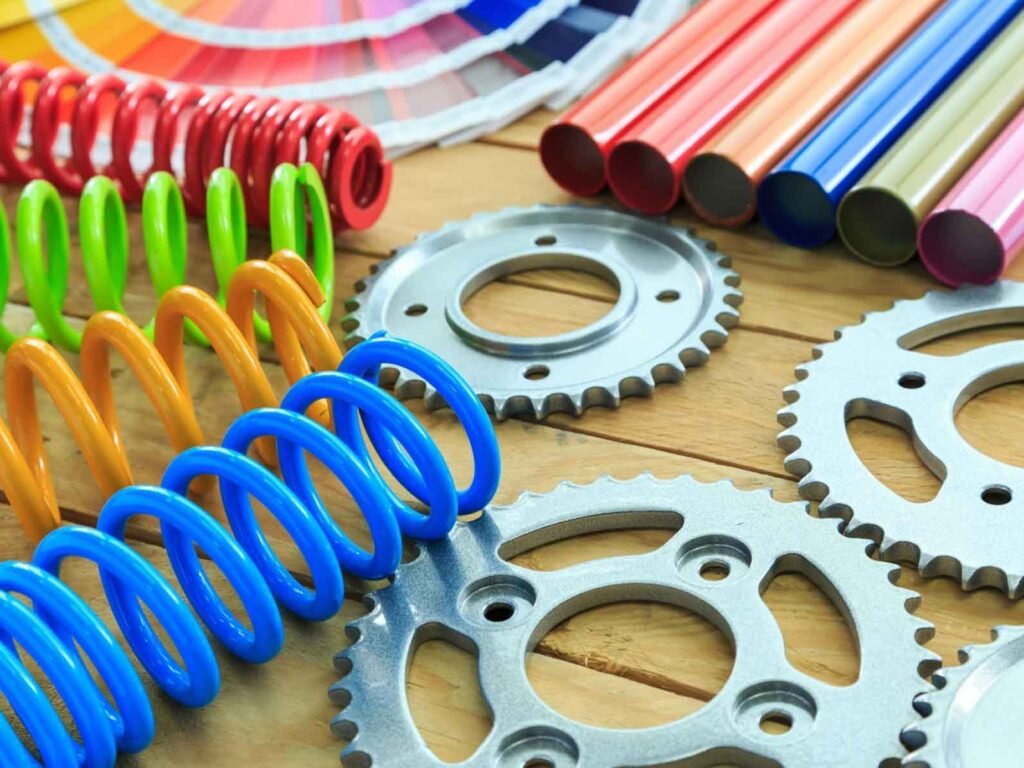Aluminum and its alloys present unique challenges when it comes to powder coating. Unlike steel, aluminum surfaces are naturally smooth and covered with an uneven oxide layer. This oxide layer, along with oils, dust, and other residues accumulated during processing, makes it difficult for the coating to adhere properly. Without proper surface preparation, powder coatings on aluminum are prone to poor adhesion, peeling, and reduced durability.
Chemical oxidation treatment for aluminum and its alloys is a crucial surface preparation step. This process includes both degreasing and phosphating, which help remove contaminants and enhance the surface for better coating adhesion. Aluminum cannot be treated with strong alkaline degreasers like steel, so neutral or mildly alkaline degreasers are used instead. Phosphating methods for aluminum include chromate phosphating, zinc phosphating, and chromic acid treatments.
To fully understand how these treatments work and why they are essential, let’s dive deeper into the specific processes and their impact on aluminum surfaces.
Types of Chemical Oxidation Treatments for Aluminum and Its Alloys
1. Chromate Phosphating
Chromate phosphating involves the use of a phosphating solution mainly composed of phosphoric acid, chromic acid or chromates, fluorides, and accelerators. The pH value typically ranges from 1.5 to 3.0. The resulting phosphate coating varies in appearance from a bright rainbow hue to an emerald green, depending on the coating weight (0.1-0.5g/㎡). The main components of the phosphate coating include hydrated chromium phosphate (CrPO₄·4H₂O) with hydrated chromium oxide (CrO₃·xH₂O), and aluminum salts and oxides that accumulate at the interface between the aluminum and the phosphate coating. Its basic molecular formula is: Al₂O₃·2CrPO₄·8H₂O.
Characteristics of Chromate Phosphate Coatings:
- The coating is non-crystalline, dissolving in dilute nitric acid ester, but after heat drying, it becomes resistant to dissolution in nitric acid.
- The coating is relatively thin, with a coating weight below 1g/㎡.
- Chromate phosphating is simple, reliable, and easy to execute.
- Low investment and operating costs.
- The coating is non-toxic.
Chromate phosphating can be applied by spraying or immersion. The immersion process follows these steps: degreasing → water rinse → alkaline etching → water rinse (warm water rinse) → activation → water rinse (flowing water) → chromate phosphating → water rinse (flowing water) → water rinse → deionized water rinse → aging. Below are the details for each step:
- Degreasing: Typically uses weak alkaline or neutral degreasers at a temperature of 45-60°C for 1-3 minutes.
- Alkaline Etching: Uses a solution containing 50-80g/L of sodium hydroxide at 50-60°C for 2-3 minutes.
- Activation (Acid Cleaning): Dissolves surface oxides and impurities, and removes non-metallic silicon. For pure aluminum and hard aluminum, a nitric acid solution (nitric acid/water = 1/2) is used at room temperature for 1-2 minutes. For aluminum alloys, a nitric acid/hydrofluoric acid solution (3/1) is applied at room temperature for 0.5-1 minute.
- Chromate Phosphating: The bath solution pH is kept between 1.4-2.0, at a temperature of 20°C for 8-10 minutes.
- Deionized Water Rinse: Prevents metal ions and chlorine ions from damaging the coating, performed at 40-50°C for 0.5-1 minute.
- Aging (Drying): The chromate phosphate coating is dried at 60-70°C until all moisture is removed, which enhances the adhesion and stability of the phosphate layer.
Phosphating Solution Formulations and Process Conditions for Aluminum and Its Alloys
| No. | Formulation (g/L) | Process Conditions |
| 1 | H₃PO₄: 28-40, CrO₃: 5-7, NaF: 3-7 or HF: 3.6mL/L | Temperature: 20-30°C, Time: 12-15min |
| 2 | H₃PO₄: 20-150, CrO₃: 10-20, HF: 2-6 | Temperature: 40-60°C, Time: 0.5-5min |
| 3 | CrO₃: 10-16, H₃PO₄: 30-50mL, NaF: 4-8, Ni Salt: 5-8 | Temperature: Room temp (25°C), Time: 8-12min |
| 4 | PO₄³⁻: 20-100, CrO₃: 6-20, F⁻: 1.5-6 | Temperature: 40-50°C, Time (spraying): 10-30s, Time (immersion): 0.5-2min |
| 5 | CrO₃: 2-20, H₃PO₄: 5-60mL/L, NaF: 3-10 | Temperature: Room temp, Time: 10-15min |
2. Zinc Phosphating
The zinc phosphating process, which is typically used for steel parts, can be adapted for treating aluminum and its alloys with some modifications. To penetrate the oxide layer on aluminum, compounds like fluorosilicates and fluoroborates are added to the phosphating solution. The primary component of the coating produced by zinc phosphating is zinc phosphate, which forms a silver-gray layer on the surface. The key ingredients in zinc phosphating solutions include phosphoric acid, acidic zinc phosphate, and fluorides (or free hydrofluoric acid).
Phosphating Solution Formulations and Process Conditions for Aluminum and Its Alloys
| No. | Formulation (g/L) | Process Conditions | Processing Method |
| 1 | Zn²⁺: 1-7, PO₄³⁻: 7-15, NO₃⁻: 4-20, F⁻: 1-10 | Temperature: 40-60°C, Time: 1-2 min | Spraying |
| 2 | Zn²⁺: 7, PO₄³⁻: 10, NO₃⁻: 20, BF⁻: 10 | Temperature: 60-65°C, Time: 1-3 min | Spraying, Immersion |
Zinc phosphating is commonly used to treat mixed metal components that include aluminum, iron, and zinc, but it is less frequently applied solely to aluminum parts. This is because the corrosion resistance of the phosphate coating formed on aluminum is significantly lower compared to the conversion coatings produced by chromate phosphating or chromic acid treatments.
Additionally, iron-based phosphating solutions with added fluorides can also be used for treating aluminum and its alloys, though this method is primarily applied when aluminum parts are processed together with other metal components. This highlights the limitations of zinc phosphating when used exclusively for aluminum, making it more suitable for mixed material treatments.
3. Chromic Acid Treatment
Chromic acid treatment involves an acidic solution primarily composed of hydrofluoric acid, chromic acid, or chromates. Some formulations also contain fluorides, ferricyanides, copper compounds, or tungsten compounds, which act as oxidation accelerators. The pH of the solution typically ranges between 1.8 and 3.0. The resulting coating weight is between 0.3-2.0g/㎡, and its color varies from bright yellow-rainbow to brown.
The coating formed through chromic acid treatment on aluminum and its alloys is non-crystalline and often exists in a colloidal state. Under high magnification, the dried surface shows a characteristic micro-cracked appearance, which is a unique feature of this treatment. This treatment is widely used for improving corrosion resistance and paint adhesion on aluminum surfaces.
Chromic Acid Treatment Solutions and Process Conditions for Aluminum and Its Alloys
| No. | Type | Formulation (g/L) | Process Conditions | Processing Method |
| 1 | Non-accelerated | CrO₃: 3-4, Na₂Cr₂O₇: 3-4, NaF: 0.8 | Temperature: 25-30°C, Time: 30-60s | Spraying |
| 2 | Non-accelerated | CrO₃: 15-20, NaF: 4-6, Na₂SiO₃: 5-8 | Temperature: 35-40°C, Time: 5-30min | Immersion |
| 3 | Accelerated | CrO₃: 4, NaF: 1, K₃Fe(CN)₆: 0.5-0.7 | Temperature: 30-35°C, Time: 25-30s | Spraying |
The coating formed by chromic acid treatment is extremely thin, typically around 1μm, and provides low contact resistance, making it highly advantageous for welding applications. In fact, it outperforms the chromate phosphating process in this regard. However, due to environmental pollution and toxicity concerns from the discharge of pollutants, its use is highly restricted.
There are numerous formulations and process variations for surface treatment solutions for aluminum and its alloys. Below is a table that references some typical treatment formulations and process conditions. Additionally, passivation treatments can significantly enhance the corrosion resistance of the coating. For example, passivation is commonly done by immersing the treated part in a 1g/L solution of potassium dichromate at room temperature for 4-5 minutes.
Reference Formulations and Process Conditions for Surface Treatment of Aluminum and Its Alloys
| Treatment Solution | Composition (g/L) | Temperature (°C) | Time (min) | Notes |
| H₃PO₄, CrO₃, NH₄HF₂, (NH₄)₂HPO₄, H₃BO₃ | 50-60, 20-25, 3-3.5, 2-2.5, 1-1.2 | 30-36 | 3-6 | Coating color: from colorless to light blue, red-green, thickness: 3-4µm, suitable for aluminum and its alloys |
| H₃PO₄, CrO₃, NaF | 45, 6, 3 | 15-35 | 10-15 | Thin film, excellent corrosion resistance, no sealing treatment needed, ideal for deformed aluminum alloys |
| CrO₃, NaF, K₂Fe(CN)₆ | 4, 1, 0.5 | 30-35 | 0.5 | Thin film, excellent conductivity, suitable for applications requiring conductivity |
| Na₂CO₃, Na₂CrO₄, NaOH, H₃PO₄, H₂CrO₄, NaF, Surfactant | 50, 15, 2-2.5, 24, 4-5, 1-2, 1 | 80-100 | 4-5 | Yellow chromate coating, thickness: 0.5-1µm, suitable for pure aluminum, aluminum-iron, and aluminum-magnesium alloys |
In the pretreatment equipment system, it is essential to conduct routine inspections of pipes, pumps, and valves. Any leaks, spills, or drips of acidic or alkaline solutions should be promptly addressed. Install pressure-reducing valves and shut-off valves along the segmented steam pipelines, and continuously monitor heaters, heat exchangers, and steam lines for potential overpressure to ensure system safety and efficiency.
4. Chromium-Free Surface Treatment for Aluminum
The previously discussed pretreatment processes for aluminum and its alloys involve the use of chromic acid, chromates, and phosphates, which have environmental impacts. As a more eco-friendly alternative, chromium-free nano-ceramic or silane treatment technologies are increasingly used for aluminum and its alloys. The CT-783 chromium-free aluminum surface treatment agent is specifically designed for forming a non-chromate conversion coating on aluminum sheets and components. This product is primarily used as a pretreatment agent before the application of polyester powder coatings.
1. Required Chemicals and Tools:
- Chemicals:
- CT-783M Chromium-Free Aluminum Surface Treatment Agent (for initial tank setup)
- CT-783R Chromium-Free Aluminum Surface Treatment Agent (for replenishment)
- LN-861 Chromium-Free Passivator (for pH adjustment)
- Test Equipment:
- PHS-25 pH meter
- 250mL beakers and 10mL pipettes
- 0.1N Sodium hydroxide, Bromophenol blue indicator (B, P, O)
2. Treatment Equipment:
The treatment tank should ideally be made from SUS-304/SUS-306 stainless steel, with pumps and nozzles made from SUS-316 stainless steel. Other corrosion-resistant alloys or materials are also acceptable.
3. Treatment Process:
Both spraying and immersion methods can be used. The specific steps include:
- Alkaline cleaning
- Rinsing with water
- Acid pickling
- Rinsing with water
- Deionized water rinse
- Treatment with CT-783 agent
- Deionized water rinse
- Drying
- Powder coating application
4. Tank Setup (For 1000L of Treatment Solution):
- Fill the tank to 80% full with deionized water.
- Add 10-75kg of CT-783M, and mix thoroughly.
- Measure the pH value, ensuring it falls between 2.5 and 3.5, and check for free acidity at 0.5-5.0 Pt. If the pH exceeds 3.5, adjust with LN-861 Chromium-Free Passivator to bring it within the correct range.
5. Management of Treatment Solution:
- pH value: Maintain between 2.5 and 3.5 for both spraying and immersion methods.
- Free acidity: Maintain between 0.5 and 5.0 Pt for both spraying and immersion.
- Temperature: Maintain between 20-30°C for both methods.
- Processing time: Maintain between 30-90 seconds.
6. Replenishment (For a 1000L Tank):
- pH value: Adjust by adding CT-783R to maintain pH levels.
- Free acidity: Each 2.5kg of CT-783R added increases free acidity by 1 Pt.
7. Concentration Testing:
- pH value: Take 20mL of solution from the tank, place it in a 250mL beaker, and measure the pH using a PHS-25 pH meter calibrated with pH 4.00 and 6.86 standards.
- Free acidity: Take 10mL of the treatment solution, add 5-8 drops of Bromophenol blue indicator, and titrate with 0.1N Sodium Hydroxide until the color changes from light yellow to light blue. The amount of sodium hydroxide used (in mL) represents the free acidity level.
Conclusion
In summary, chromium-free aluminum surface treatment is an environmentally friendly alternative to traditional chromate-based processes, offering excellent adhesion and corrosion resistance for aluminum and its alloys before powder coating. The use of CT-783 chromium-free treatment agent ensures high-quality results while reducing environmental impact. The process involves careful management of pH levels, temperature, and free acidity, with both spraying and immersion methods delivering effective treatment. For businesses looking to adopt more sustainable surface treatment methods, this chromium-free approach is an ideal solution.
Looking for reliable powder coating equipment? Contact us today for top-tier solutions!





